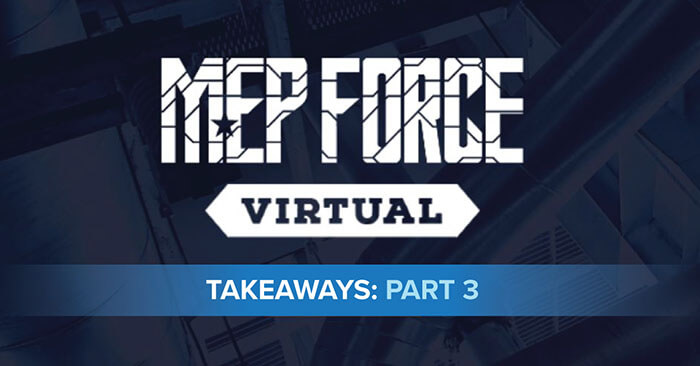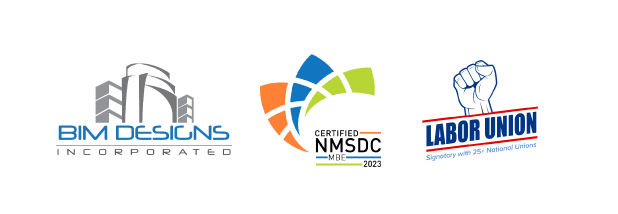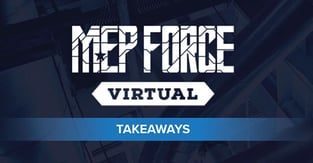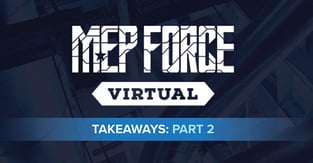
MEP Force 2020 is the only conference that’s focused entirely on Mechanical, Electrical, and Plumbing (MEP) trades. Put on by our friends at Applied Software, this year’s conference was held virtually. Here are some of the key takeaways we gathered about tech and trends. One of the underlying themes to a lot of the side conversations and weaved throughout panels was the impact of COVID-19 on the construction industry.
During the conference's Virtual Happy Hour, BIM Designs' Head of Sales, Steve Couch, demonstrated how to braise a pork loin to perfection. To see how he did it, check out the video in our blog, and for more key takeaways from MEP Force 2020, continue reading the rest of our blog.
Life After COVID-19
One silver lining to the whole COVID-19 situation is that it has forced some more traditional companies to adopt new technology. That’s going to be crucial in moving forward in the industrial design and fabrication industry.
Despite the inherent slow down in the prefabrication market, there is also a lot of pent up demand – especially for high-value healthcare and DfMA (Design for Manufactured Assemblies) opportunities - if you do it right. James Simpson also expressed there may be new markets for prefab: retrofits. While retrofits haven’t traditionally been targets for prefabrication manufacturers, the increased focus on health and safety may
change that.
When you think about the hotel industry, there will be a need to retrofit bathrooms and remove soft surfaces with hard surfaces that are easier to clean. The same would apply to elderly care facilities and assisted-living facilities. The concern, though, is that it’s not as easy as just swapping things out. There are concerns about ADA, the slip factor, and other health regulations.
It’s another example of how complex the design/build process can be. Think about groups that are in the construction phase of large-scale convention centers. Should they retool? Should they proceed? Will more meetings become virtual and lessen demand for large spaces?
Amy Marks, the self-proclaimed Queen of Prefab at Autodesk talked up DfMA as a method of design that makes manufacturing easier by creating a collection of parts that form products. This allows you to optimize the manufacturing process better through design choices. When design changes are needed, DfMA makes it easier to accomplish for better, industrialized construction.
Marks is one of many speakers forecasting that demand for manufacturing automation and industrialized construction will soar once the coronavirus pandemic settles down.
3D Visual Experience
Charles de Andrade, COO/CFO at VIM, talked about improvements in visualizing designs using a 3-D virtual experience. Visualizing ahead of time versus fixing them after the fact provides:
- Increased efficiency
- Reduction in time and cost due to rework
- Less frustration
He talked about the renovation of a rundown structure in China that needed to deliver detailed information to the government. Utilization of point clouds and Revit allowed for a 3D virtualization for the historical remodel. In this case, the tech gave engineers the ability to better understand rebar in each area and give total counts for rebar per column. Teams used the visual tech to guide assembly which allowed for offsite manufacture and bundling for shipment to the construction site.
3D visualization was also used in the construction of a prison in Peru in 2019. Using magic leap glasses, the country’s finance minister was able to walk the entire project and visualize it even though the site was only 5% built. This helped the finance minister see what they were paying for.
APIs can now present entire structures. Since it can hold all of the BIM data, that means you can see the whole structure at once rather than have to strip out the segments and view them independently.
During an excavation project at Tugaloo College in Mississippi drones were deployed to help reconstruct an as-built model compared to the original design. The drones had to be used to land map the historic site. Then, point clouds were used to capture both the exterior and interior, exported as planes, and populate into Revit. This allowed for remote meetings and a virtual walkthrough for people unable to visit the site in person.
The 3D Visualization process helps with the current COVID-19 situation but has benefits that go well beyond remote meetings. Bret Slawnikowski, Senior Account Manager at FARO Technologies discussed how non-contact augmented reality allows stakeholders to get a feel for finished construction, but also provide significant benefits for operators, such as:
- Accurately locate parts virtually
- Show locations and alignments of parts
- Position components without the need for physical templates
By projecting multiple shapes at the same time within a workspace, you can visualize a workflow build sequence without needing to reset after each step.
About BIM Designs, Inc.
BIM Designs Inc. is an agile BIM detailing, modeling, consulting, and coordination service provider. We work closely with architecture, engineering, and construction (AEC) contractors and developers that require experienced journeymen detailers and engineers for Mechanical, Electrical, Plumbing, and Fire Protection (MEPF) modeling, Laser Scanning, and Virtual Design Construction (VDC) services. BIM Designs, Inc. is a signatory with 18 UA and SMART unions in multiple states.

About the Author
Luke joined the BIM Designs team in June 2020 as the Head of Business Development and helps oversee the business development and marketing team's objectives. With over 8 years of business development and sales experience working with startups, accelerators, investors and global enterprise-level companies, he has successfully helped startups scale their sales operations. Previously, he worked in the biotech industry as a research leader for over 9 years resulting in an IPO in 2011.





